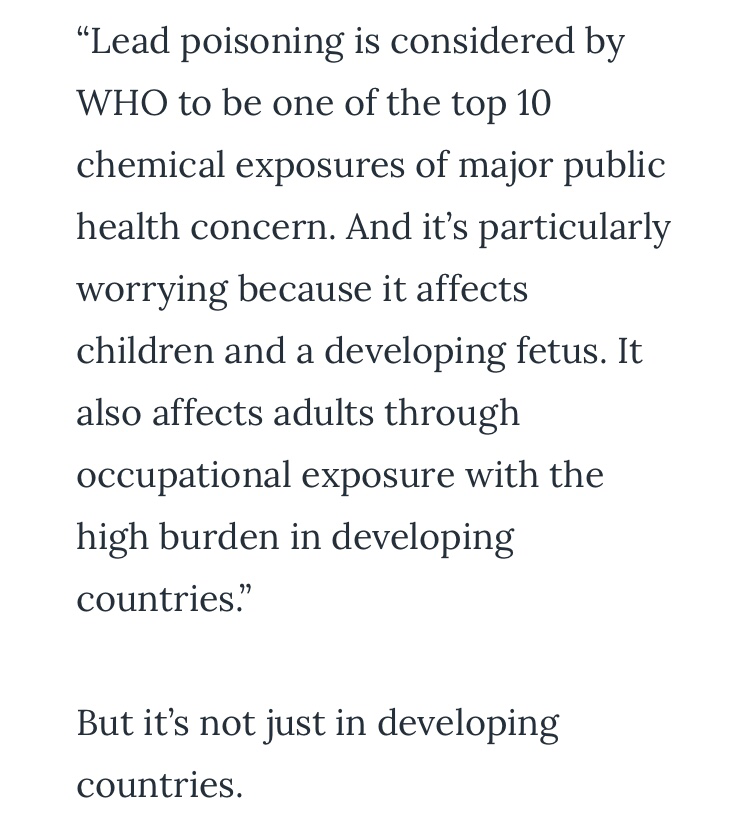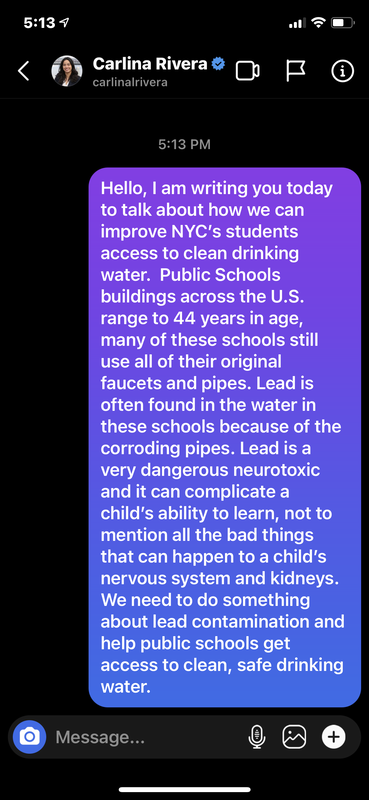How Can We Improve Access To Sustainable, Drinking Water & Reduce Lead Exposure?
DID YOU RECEIVE AN ENVELOPE CONTAINING A LEAD TEST SWAB?
CLICK IMAGE ABOVE FOR INSTRUCTIONS
CLICK IMAGE ABOVE FOR INSTRUCTIONS
Students and staff at Union Square Academy for Health Sciences High School have been engaged in action civics and service learning connected to improving access to sustainable drinking water and reducing lead exposure since we first learned in 2017 that many of the water fountains in our school had tested positive for elevated levels of lead. Even prior to this discovery, school water fountains were often neglected, unused and students would miss instructional time trying to obtain water from often empty water coolers that were located in administrative spaces that were not always accessible.
In 2021, our activism to map this problem and install new water filling stations and lobby elected officials for policy change was highlighted on WNYC and Gothamist.
In 2020, our work was acknowledged as a United Nations Sustainability Goal Project of The Year awarded by Goethe Institut
This website along with this project presentation was designed and is being updated with the help of students to showcase our work
In 2021, our activism to map this problem and install new water filling stations and lobby elected officials for policy change was highlighted on WNYC and Gothamist.
In 2020, our work was acknowledged as a United Nations Sustainability Goal Project of The Year awarded by Goethe Institut
This website along with this project presentation was designed and is being updated with the help of students to showcase our work
What's the problem?
Not long after the Flint water crisis came to national attention in 2015, concern started mounting about the drinking water in public schools across the United States as these buildings average 44 years in age, and many still use their original pipes and faucets. Lead, is found in water due to the corrosion of old lead pipes or the solder that connects pipes, and also in paint, soil and dust. Lead acts as a powerful neurotoxin. It can reduce a child’s ability to learn and damages the central nervous system, kidneys and blood. Lead contamination is an alarmingly common problem in schools. In New York City, many of the school buildings are older than the national average and tested positive for lead.
You can see the results of the city’s testing in our custom google map students and I created with the help of international sustainability coaches to illustrate this problem. Students also created the video above in German with English subtitles below to discuss this problem and solutions
You can see the results of the city’s testing in our custom google map students and I created with the help of international sustainability coaches to illustrate this problem. Students also created the video above in German with English subtitles below to discuss this problem and solutions
Public Health Issues Like Lead are a Social Justice issue too!
Low-income and minority communities often face disproportionately high pollutant exposures. Before Freddie Gray was killed by police in Baltimore in 2020, a court filing in 2008 against a former landlord shows Gray and his two sisters were all found to be suffering from lead poisoning.
Exposure to lead can diminish cognitive function, increase aggression and ultimately exacerbates a cycle of poverty and systemic racism. A child poisoned with lead is seven times more likely to drop out of school and six times more likely to end up in the juvenile justice system.
Exposure to lead can diminish cognitive function, increase aggression and ultimately exacerbates a cycle of poverty and systemic racism. A child poisoned with lead is seven times more likely to drop out of school and six times more likely to end up in the juvenile justice system.
Collaborating Internationally: What we learned from Germany?
With support from the Goethe-Institut of New York, social studies teacher David Edelman and Dental Technology teacher David Barthold, invited a group of students and teachers from the Heinrich Zille School in Radeburg, Germany to visit USA High School. German students and teachers experienced our technical education program and civic engagement through participating in student led classroom caucuses and discussing issues related to their respective communities. Students also collaborated on writing this report in German and create the infographic above and the video below.
Students were surprised to learn that although leitungswasser, tap water in Germany, was clean and safe to drink, that most people consume bottled mineral water instead. Also water fountains are much less common. German students described the process and culture of recycling and were equally as surprised to learn there is no deposit on bottled water bottles in NY and that bottle deposits on other beverages are significantly less in America. Students worked together to research and identify new information about tap water in each other's countries.
 Students from USA High School collaborate with students and teachers from Heinrich Zille School in Radeburg, Germany during their classroom caucuses to learn about each other's community problems and discuss potential solutions.
Students from USA High School collaborate with students and teachers from Heinrich Zille School in Radeburg, Germany during their classroom caucuses to learn about each other's community problems and discuss potential solutions.
Students also researched and evaluated WHO & EPA standards. Articles and teaching tools used to help guide students in this process, connect to the academic goals of helping students analyze complex informational texts for claims, argument, evidence and bias.
Testing: Where is the problem?
During remote learning at the end of the 2019-2020 school year, several students worked together to create the google map above, which uses various data points made available to the public to track city schools with elevated lead levels in their water. Since New York enacted legislation mandating new public water tests for lead in 2016, there have been 3 rounds of testing. These data points are fully integrated into our map. Red indicates a school has water that’s been tested above 15 ppb, the EPA’s limit and requirement for remediation. If you click on a school’s post remediation status, you can see the number of faucets that are still elevated along with the school populations’ poverty and economic need index (as made available within the DOE’s data portal).
During the 2020-2021 school year, students and staff at USA retested their school’s water supply since the city’s remediation efforts. Similarly, students and staff have also begun testing their water at home using a lead test kit. Below see a tutorial of this process. Students in government and chemistry classes will be analyzing results and their findings will be a springboard for continued student led activism. We plan to share the results of our at home testing by borough.
NYC and New York State offer free lead testing to there residents, as do many other states and municipalities across the US. Order a kit, test your water and then anonymously report your results and zip code to us using the above form to help us pr provide provide data about this problem and advocate on your behalf. During and post covid school closures students have tested their tap water at home.
Student Led Activism: What have we done?
Students often know best how money should be spent to address the needs of their schools. Using Participatory Budgeting funds students developed and voted on a proposal to install new environmentally friendly water fountains.
Students also produced a short documentary film about it above. Students also collaborated on a unit plan to help educate students and provide a resource to teachers interested in getting students involved in evaluating the city's water quality and student led activism. Students and teachers are planning to pursue action civic projects and student led activism to rally support around these policies and increased water testing as well as and lobby elected officials to pursue the changes identified below.
Students also produced a short documentary film about it above. Students also collaborated on a unit plan to help educate students and provide a resource to teachers interested in getting students involved in evaluating the city's water quality and student led activism. Students and teachers are planning to pursue action civic projects and student led activism to rally support around these policies and increased water testing as well as and lobby elected officials to pursue the changes identified below.
Common Sense Proposals To Improving Access To Safe Drinking Water
1. Share the results of lead test kits by zip code to help inform the public about severity of the problem by locality
2. Require that all testing data for public drinking water be published, as opposed to providing data only for the faucets that test above the EPA standard of 15 ppb because there is no safe level of lead
3. Communicate the number of fountains and filtered fountains to ensure access to water isn't restricted or been limited by remediation efforts
4. Lower the action level to 5 ppb in public schools which is more aligned to the Natural Resources Defense Council and the Healthy Schools Network's proposition, but easily tested within a normal range of 0.5 expected variation identified by environmental testing professionals
The new water fountain filters are rated for 3,000 gallons, which is about 24,000 16-ounce bottles. Actual filter life will depends on water conditions. It's also recommend to change the filter at least once a year. See the full specs below.
The new fountains reduce the time students spend outside of class attempting to get water and will ultimately pay for themselves now that the school no longer needs to purchase water cooler refills. Students also identified additional environmental benefits as students buy and use less bottled water and the school reduced its carbon footprint since they no longer order replacement water jug refills delivered by trucks that add to pollution and congestion.
The new fountains reduce the time students spend outside of class attempting to get water and will ultimately pay for themselves now that the school no longer needs to purchase water cooler refills. Students also identified additional environmental benefits as students buy and use less bottled water and the school reduced its carbon footprint since they no longer order replacement water jug refills delivered by trucks that add to pollution and congestion.
How does this connect to Career & Technical Education?
Our student leaders with the help of our sustainability coaches consulted a water safety expert to learn more about the tests one could buy to screen the chemical and biological safety of drinking water. Below are our notes about the tests we were able to order to retest our drinking water at school using our Goethe mini grant funding. Additionally students studied how samples are tested and why they are linked to drinking water safety.
Legionnaires Testing - is ideal for testing a building’s heating or cooling units such as boilers or air conditioners. We learned that this test is both expensive and not ideal for faucets as legionnaires is much more likely contracted by inhaling air from these building components as opposed to a water fountain. A fully automated testing device can now be deployed at water sites suspected of contamination by Legionella bacteria.

A Flame AA burner assembly The light gray part is the burner head, and the line is where the flame will come out. The detector reads right above the burner head, through the flame when it is lit. The minimum detection by flame is about 50-75 ppb on a really good day, 100 ppb is normal. Upper limit is about 5000 ppb, maybe a bit more. A graphite furnace tops out around 75-100 ppb, so the two work well together.
Lead, Iron, Copper Testing - Most heavy metals in the water supply cannot be detected by sight, smell or taste. Lead is the most dangerous and unsafe in any quantity. Iron overload is uncommon but can lead to hemochromatosis, which can cause damage to the liver, heart, and pancreas. The EPA has set a goal for copper at a maximum allowable level of 1.3 mg per liter to protect against short-term gastrointestinal tract problems. Atomic Absorption Spectroscopy Graphite Furnace machine is used and is accurate to 0.5-1 ppb. ICP-MS: Inductively Coupled Plasma – Mass Spectrometer is probably the most sensitive piece of equipment you can get for trace metals analysis. The detection limit for an ICPMS for lead is accurate to 0.05 ppb but is a much more expensive machine running around $200k and as a result is more expensive to use to test drinking water for harmful elements
Heterotrophic Plate Count Testing - is a procedure for estimating the number of live bacteria in water. Heterotrophic plate count levels in potable water should be <500 CFU/mL. These levels may increase on occasion, but counts consistently >500 CFU/mL would indicate a general decrease in water quality. Water is cultured, grown out and measured.
pH Testing - is a measure of how acidic/basic water is. The range goes from 0 to 14, with 7 being neutral. pHs of less than 7 indicate acidity, whereas a pH of greater than 7 indicates a base. The pH of water is a very important measurement concerning water quality. Since pH can be affected by chemicals in the water, pH is an important indicator to know if water is changing chemically. pH is easily tested with a test strip or meter.
Conductivity Testing - Pure water is not a good conductor of electricity. Ordinary distilled water in equilibrium with carbon dioxide of the air has a conductivity of about 10 x 10-6 W-1*m-1 (20 dS/m). It’s possible for these readings to change substantially after pollution gets into the water, evaporation occurs, or natural flooding takes place. Conductivity is often used to make sure plants and animals in the water don’t suffer as a result of changes to their environment and frequently reported with a meter that reads in Siemens per meter or microSiemens per meter. Conductivity is roughly an inverse measure of TDS. Students used a conversion program illustrated below to convert between these two units.
Hardness Testing for Calcium & Magnesium - The term hardness, a measure of the mineral content of water comes from an expression of how difficult or "hard" it is to wash clothes with the water. When soap is mixed with hard water, these minerals combine with the soap and decreases the cleaning efficiency of the soap. Test strips, a colorimeter, or spectrophotometer if often used to test a water’s hardness.
Total Dissolvable Solids Testing-
A TDS meter, an inexpensive small hand-held device can be used to test the sentiment level of water. Students tested our school’s drinking water using a TDS meter to determine total dissolvable solids. Students were curious to know if the water from our new water fountains and bottle fillings stations with filters had lower TDS levels than the old unfiltered water fountains and facuets.
A TDS meter, an inexpensive small hand-held device can be used to test the sentiment level of water. Students tested our school’s drinking water using a TDS meter to determine total dissolvable solids. Students were curious to know if the water from our new water fountains and bottle fillings stations with filters had lower TDS levels than the old unfiltered water fountains and facuets.
TDS meters can’t detect small atomic particles like lead that can render water unsafe to drink. That’s why it is important to run tests that specifically designed to detect harmful elements.
Students practiced converting Total Dissolvable Solids in ppm from their TDS meter readings to Siemens, which is used as a measure of Conductivity. A link and illustration of this conversion tool is below.
Students and staff analyzed our drinking water through professional environmental testing of bottled samples and using a consumer product to self test for water safety
We will share and compare our findings as they are made available in the embedded google sheet below.
Additionally, Illinois and D.C. have lowered their lead action level to 5 ppb. Vermont lowered its action level to 4 ppb and the FDA's action level for lead contamination in bottled water is 5 ppb.

Students have been working to draw attention to the resources available to learn more about how elected officials across the country have addressed or have failed to address the need to help ensure our country’s drinking water is safe and accessible to all. Above is a water safety report card that have been created based upon state regulation and procedures in place to ensure their state residents’ drinking water in safe. Click on the link above to learn more about why your state received this letter grade



















